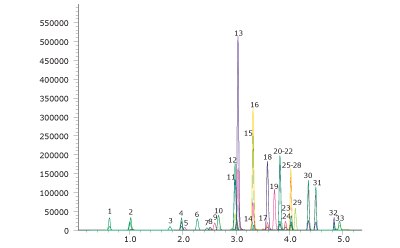Fast and High-Resolution LC-MS Separation of PFAS
Petra Lewits, Cory Muraco, Product Manager Liquid Separations, Johanna Simon, Scientist Central Analytics
Merck

PFAS (Per- and poly-fluoroalkyl substances) are persistent, man-made organic compounds, widely found in the environment. Recent awareness about their toxicity has led the U.S. Food and Drug Administration (FDA) and the U.S. Environmental Protection Agency (EPA) to initiate actions against PFAS. Hence reliable and fast methods for their determination are needed.
EPA has developed, validated, and published three methods to support the analysis of 29 PFAS in drinking water, Method 533, 537 and 537.1. EPA 8327 covers the analysis of selected per- and polyfluoroalkyl substances (PFAS) in prepared extracts of various matrices (e.g., waters and solids) by liquid chromatography/tandem mass spectrometry (LC-MS/MS) analysis.
As technological advancements continue to progress, mass spectrometers will continue to be improved regarding their level of sensitivity, mass resolution, and scanning speed. This will impact future developments in PFAS analysis, and column performance must be able to handle these advancements. With this in mind, the below method for the separation at maximum speed was developed to test the suitability of the columns for use in these advanced conditions.
The column of choice for PFAS analysis by LC-MS(/MS) is a C18 column. The Ascentis® Express PFAS columns are based on superficially porous silica particles (SPP) with C18 modification and are specifically tested using a PFAS compound mixture. This ensures the suitability and reliable performance of these columns for an efficient PFAS analysis.
PFAS compounds originating from the HPLC system and materials used for the analysis are a concern. Therefore, it is recommended to place a delay column before the injection port in the system (Figure 1). The Ascentis® Express PFAS Delay column provides exceptionally high retention of PFAS compounds across the various mobile phase conditions. It efficiently delays the PFAS background contamination that originates from the instrument and therefore prevents co-elution with the PFAS compound present in the sample (Figure 1).

Figure 1.LC-MS instrumental set-up for PFAS analysis & results of perfluorooctanoic acid (PFOA) (MRM 413.0>368.0) using a delay column.
LC-MS Analysis of PFAS - 33 Compounds in 5 minutes
The rapid separation of 33 PFAS compounds found in EPA 537.1, EPA 533, and EPA 8327 demonstrates that the Fused-Core® technology of Ascentis® Express PFAS HPLC columns benefits the PFAS analysis for fast, efficient, and rugged separations― paramount to environmental analysis (Figure 2).

Figure 2.33 PFAS Compounds in 5 min (see conditions below).
See more for PFAS testing at SigmaAldrich.com/PFAS
Discover our range of PFAS certified reference materials (CRMs) and analytical standards for reliable PFAS analysis and quantification. Click here to see the full list.
Certified Reference Materials (CRMs)
Analytical Standards
如要继续阅读,请登录或创建帐户。
暂无帐户?